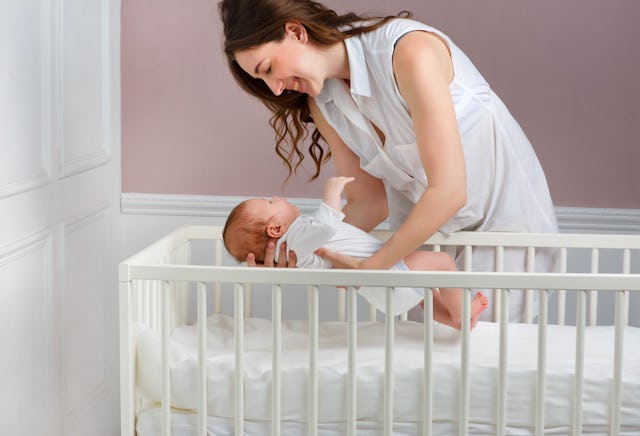Revised Safe Sleep Guidelines Warn Against Weighted Blankets, Any Form of Co-Sleeping
In the first update their guidelines in five years, the American Academy of Pediatrics also warned against home cardiorespiratory monitors.

If you’ve ever parented an infant, you’ve struggled with their sleep: how to get them down, how to keep them snoozing for more than twenty minutes, how to transfer them from your arms into the crib without waking them up — again. Then when they finally are asleep, you worry — how could you not? — about Sudden Infant Death Syndrome (SIDS) or suffocation, and run to check that they’re still breathing. It all makes for a very exhausting first twelve months of parenthood.
While the American Academy of Pediatrics doesn’t have the magical formula that will get you and baby a good night’s sleep, what they are offering is this: clarity. In the first update to their safe sleep guidelines since 2016, the group has come out firmly against co-sleeping, any bedding or crib decor, and weighted blankets or swaddles. (Non-weighted swaddles are not recommended once baby is able to roll over, which usually happens around 3 or 4 months.)
Approximately 3,500 babies die in the United States every year from sleep-related infant deaths, including SIDS and accidental suffocation and strangulation. After a sharp decline in the ‘90s, when back-to-sleep became a slogan, these numbers have remained fairly stagnant since 2000, and racial and ethnic disparities persist. Black and Native American babies more than twice as likely to die as white babies.
While a recent breakthrough in SIDS research shows that low levels of a particular enzyme are associated with SIDS deaths, safe sleep precautions are still recommended to reduce an infant’s risk of both SIDS and smothering accidents.
The rule that infants should always sleep on their backs remains unchanged, as it has for decades. A new clarification, coming in the wake of the recalls of inclined infant sleepers, is that sleep surfaces should be flat, not inclined. In addition, strollers, swings, carseats and carriers should not be used for “routine” sleep.
While the AAP recommends that babies never share any sleep surface with an adult, some napping spots are more dangerous than others. The risk of death is 67 times higher on a couch, “soft armchair,” or cushion. Other factors that increase risk include sleeping with someone other than a parent, someone who smokes, or someone impaired by medication, illicit drugs, alcohol, or fatigue. Babies born preterm or underweight, or less than 4 months old, are also at heightened risk.
“We know that many parents choose to share a bed with a child,” said Rebecca Carlin, MD, FAAP, who co-authored the statement and technical report. She added that families may do so “to help with breastfeeding or because of a cultural preference or a belief that it is safe. The evidence is clear that this significantly raises the risk of a baby’s injury or death, however, and for that reason AAP cannot support bed-sharing under any circumstances.”
Home cardiorespiratory monitors, which track infants’ breathing and heart rates and claim to prevent SIDS, should also not be used, according to the AAP. “There is no evidence that any of these devices reduce the risk of these deaths,” says the AAP. In addition, “the use of products claiming to increase sleep safety may provide a false sense of security and complacency for caregivers.”
The AAP does advise breastfeeding, room sharing (not bed sharing), routine vaccinations, and tummy time. Encouragingly, use of a pacifier “is associated with reducing risk.”
Acknowledging that infant sleep is a challenge for parents, Rachel Moon, MD, FAAP, lead author of the statement and technical report, explained, “Babies by their nature wake up frequently during the night. Although this can be understandably frustrating for parents who are exhausted and losing out on their own sleep, babies have to wake to feed every 2-3 hours, so this is normal and healthy, and should be expected.”
While you can reduce your baby’s risk by following the AAP guidelines, the only cure to your infant sleep woes is time — and patience.